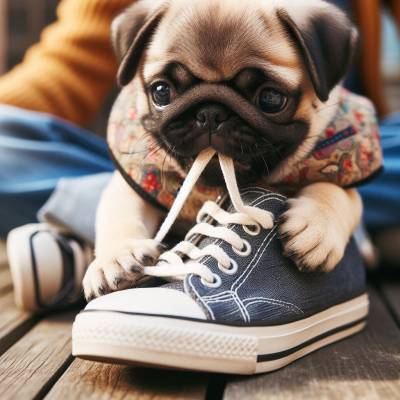Are Pugs Hard to Potty Train, or Do They Just Need a Different Approach?

Pugs, the adorable wrinkled-faced canines, are known for their unique personalities. But are they difficult to potty train? This article explores the challenges and techniques for housebreaking pugs, providing insights to make the process easier and more enjoyable for you and your four-legged companion.
I. Introduction: Are Pugs Hard to Potty Train?
A. Unraveling the Pug Personality
Pugs are a popular small dog breed known for their sweet, wrinkled faces and affectionate nature. These charming little dogs are intelligent, making them highly adaptable to various environments and suitable for many households. However, despite their intelligence, pugs can be quite strong-willed, which may present challenges in potty training. Understanding the pug breed’s unique characteristics will help determine the best approach to housebreaking your furry companion.
B. Elements Influencing Potty Training Success
Several factors come into play when potty training pugs, some of which are inherent to the breed, while others pertain to the environment and the approach used by the owner. Factors such as the dog’s age, temperament, and previous training experiences can impact the ease or difficulty of potty training. Additionally, the owner’s consistency, patience, and willingness to adapt to the dog’s needs are crucial. The following sections will explore the challenges and techniques for potty training your pug effectively.
II. Pug Potty Training Challenges
A. The Stubborn Streak: Dealing with Strong-Willed Pugs
One of the biggest challenges in potty training pugs is their stubbornness and strong-willed nature. These dogs are known for their independent spirit, which can make them resistant to training. Consequently, it is essential to approach potty training with patience and persistence, finding ways to engage your pug and make the learning process enjoyable.
B. Overcoming Pugs’ Short Attention Span
Pugs typically have a short attention span, making it difficult to focus on potty training for extended periods. This characteristic calls for creative and engaging training methods that capture and hold their interest. Breaking training sessions into shorter, more frequent periods can help maintain their focus and reinforce good habits.
C. Pugs and Weather Sensitivity
Pugs are sensitive to extreme temperatures, which can affect their willingness to go outside for potty breaks. Cold or wet weather may discourage your pug from venturing outdoors, leading to accidents inside the house. To address this, provide your pug with weather-appropriate clothing or consider indoor potty options during unfavorable weather conditions.
III. Techniques for Successful Potty Training
A. Laying the Groundwork: Establishing a Routine
- Consistency and timing: Maintaining a consistent schedule for potty breaks helps your pug understand when and where to relieve themselves. Make sure to take them out first thing in the morning, after meals, and before bedtime.
- Designated potty areas: Choose a specific outdoor area for your pug to eliminate and consistently bring them to that spot. This will help them associate the area with going potty and minimize accidents elsewhere.
B. Positive Reinforcement: Praise, Rewards, and Patience
- Praise and rewards: Provide verbal praise and a small treat whenever your pug successfully goes potty in the designated area. This positive reinforcement will encourage them to continue the behavior.
- Avoiding punishment: Punishing your pug for accidents can be counterproductive, leading to confusion and fear. Instead, calmly clean up the mess and reinforce the proper behavior during the next potty break.
C. Customizing the Approach: Adapting to Individual Needs
- Crate training: Some pugs benefit from crate training, providing a safe and secure space that encourages them to hold their bladder until taken outside.
- Indoor potty options: In cases where outdoor potty training proves difficult, consider indoor options such as puppy pads or artificial grass mats. This can make the process more manageable, especially during inclement weather.
IV. Common Potty Training Mistakes to Avoid
- Inconsistency in training: Ensure that you maintain a consistent schedule and method of training, as inconsistency can confuse your pug and prolong the process.
- Expecting immediate results: Potty training takes time and patience. Expect your pug to be fully trained after some time. Celebrate small victories and continue reinforcing positive behavior.
- Neglecting to supervise: During the initial stages of potty training, it is crucial to supervise your pug closely. This helps prevent accidents and allows you to reinforce good behavior promptly.
V. FAQs
Q: Are pugs more difficult to potty train than other breeds?
A: Pugs can be more challenging to potty train due to their stubbornness and short attention span. However, they can be successfully housebroken with consistent training, patience, and positive reinforcement.
Q: How long does it typically take to potty train a pug?
A: The duration of potty training varies depending on the individual dog and the consistency of training. It can take anywhere from a few weeks to a few months to fully housebreak a pug.
Q: Do pugs naturally prefer indoor or outdoor potty areas?
A: Pugs do not have a specific preference for indoor or outdoor potty areas. It is up to the owner to establish a designated area and train the dog accordingly.
Q: Is crate training recommended for pugs during the potty training process?
A: Crate training can benefit some pugs, providing a secure space and encouraging them to hold their bladder until taken outside. However, each dog is different, and crate training may only suit some pugs.
Q: Can weather affect a pug’s willingness to go outside for potty breaks?
A: Pugs are sensitive to extreme temperatures, and cold or wet weather may discourage them from going outdoors. Providing weather-appropriate clothing or indoor potty options can help address this issue.
Q: How can I keep my pug engaged during potty training sessions?
A: Break training sessions into shorter, more frequent periods, and use positive reinforcement such as praise and rewards to maintain their interest and motivation.
Q: What should I do if my pug is not responding well to potty training?
A: If your pug is struggling with potty training, consider consulting a professional dog trainer or seeking advice from your veterinarian. They can provide guidance and help identify any underlying issues affecting the training process.
VI. Conclusion
A. Embracing Your Pug’s Unique Personality
Understanding your pug’s quirks and temperament will help you tailor your training approach and foster a stronger bond between you and your furry friend.
B. Celebrating Milestones and Progress
As your pug progresses in their potty training journey, take time to celebrate milestones and appreciate the hard work both of you have put into the process.
VII. Suggested Readings
For those looking to dive deeper into the intricacies of potty training their canine companions, the following selection of books may serve as valuable resources:
- “Potty Training Dogs: The Ultimate Guide For A Happy Owner” – This guide offers comprehensive instructions for potty training dogs of all ages, providing various methods to suit different needs.
- “POTTY TRAINING: How to potty train your puppy in just 7 days” by Ethan Adrian – A focused program offering a step-by-step approach to potty training your pup quickly and effectively.
- “Puppy Potty Training – The Expert’s Guide to EASY Housetraining FAST” – Addressing common misconceptions and offering expert advice, this book is designed to help your dog stay in a forever home.
- “Way to Go!: How to Housetrain a Dog of Any Age” by Patricia B. McConnell – Written by a renowned author in dog behavior, this book offers insights into housetraining dogs at any stage of their life.
- “How to Potty Train a Dog: Potty Training Tips for Puppies and Adult Dogs” – This resource provides practical tips for potty training with a focus on positive reinforcement and understanding your dog’s signals.
Embarking on the journey of potty training requires patience and the right knowledge. These books offer a wealth of information to guide you through the process, ensuring that both you and your dog have a positive experience. With their help, you can establish a routine that works for you and your pet, fostering a happy and hygienic home environment.






